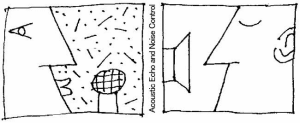|
Second-order statistics based dereverberation by using nonstationarity of speech
- Author(s)
-
- Takuya Yoshioka, (NTT Communication Science Laboratories, NTT Corporation)
- Takafumi Hikichi, (NTT Communication Science Laboratories, NTT Corporation)
- Masato Miyoshi, (NTT Communication Science Laboratories, NTT Corporation)
- Topics
-
- Sound enhancement and sound separation
|
Get the paper in PDF format
Acrobat Reader
(version 5 minimum)
is necessary to read this document.
|
Abstract
This paper addresses the problem of speech dereverberation, whose objective is to estimate the inverse filter of an acoustic system in a room (room transfer function).
It is well known that using a filter that simply whitens an observed signal deteriorates the characteristics of speech.
This is because a speech signal is temporally correlated due to a speech production system (articulatory filter).
To avoid this problem, we need to estimate the inverse filter of the room acoustic system separately from that of the speech production system because
it is the former that we want to estimate.
We recently proposed an algorithm that jointly estimates these inverse filters by exploiting the higher-order statistics of the output.
In this paper, we propose an alternative joint estimation based algorithm that uses a criterion involving only the second-order statistics of the output.
We present experimental results indicating that the proposed algorithm can estimate the inverse filter of the room acoustic system with
a reverberation time of 0.5 seconds from observed signals of 3-5 seconds.
Results obtained in the presence of additive noise are also presented showing that the proposed algorithm succeeds in the dereverberation under the noise of 20 dB.
|



